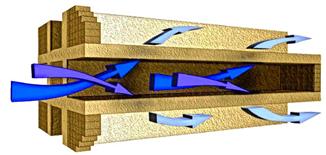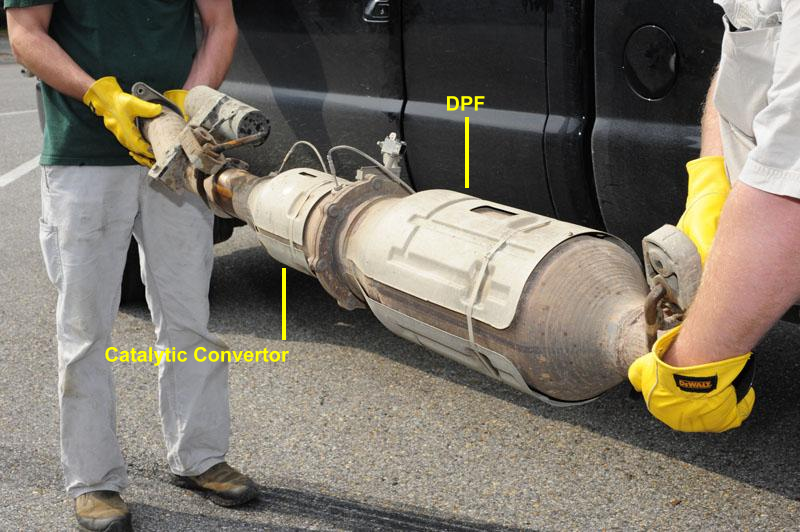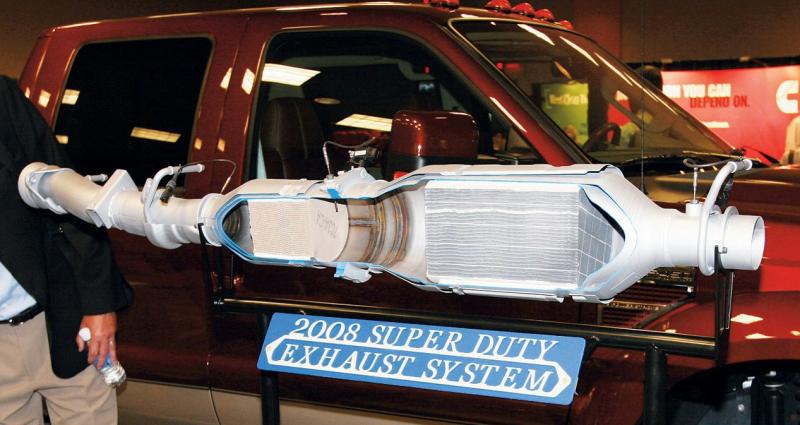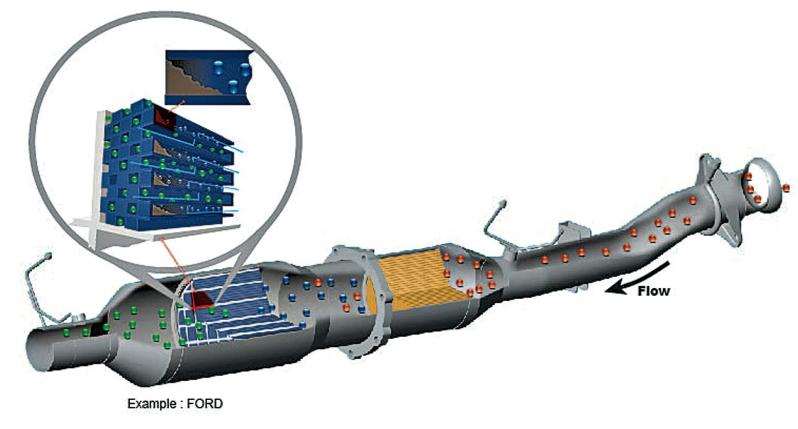Starting in 2008, Ford began using Diesel Particulate Filters (DPF) on their diesel trucks. The DPF, is responsible for eliminating particulate matter from the exhaust system, specifically the soot that is emitted by diesel engines. Diesel particulate filters are effective in removing 85 – 100 % of the soot emitted by diesel engines.
What is Particulate Matter (PM):
- carbon from incomplete combustion
- soluble organic fractions from fuel and lubricating oils
- sulfates formed from the sulfur in the fuel
How The DPF Works:
the alternating pattern of blocked passages in the core of a particulate filter is quite apparent. The opposite ends of the open cores is blocked off and the opposite ends of the blocked passages are open. This means that exhaust gasses enter the open passages and must pass through the substrate to the alternating passages and exit out the other end.
Example:

The image above shows how the exhaust enters the DPF, flows through the substrate which filters the particulate matter and allows the filtered exhaust to exit the other end.
Regeneration – or – What Is Your Truck Doing When It Says ‘Cleaning Exhaust Filter’?:
As you can imagine, a clogged DPF would lead to poor performance, efficiency, & fuel economy. To prevent the DPF from becoming clogged, a process known as Active Regeneration is used. Regeneration is the process of burning the collected soot trapped by the DPF. This process restores or maintains the DPF’s ability to allow exhaust gasses to flow through it, while preserving engine performance and efficiency. During Active Regeneration, the engine injects fuel during the exhaust stroke, which ignites in the exhaust system, and raises the temp to the 1700-2000 degree range needed to burn off what’s been collected in the DPF.
Unfortunately, This fuel also cause cylinder wall wash down, reduces upper cylinder lubrication and contaminates the engine oil in the process , which is the main reason having the DPF on is bad for the engine. And, of course, the fuel used to heat up the DPF isn’t being used to move the truck down the road so it wastes fuel reducing you MPG (see ‘Side Effects of the DPF below).
Side Effects of the DPF:
Poor Fuel Economy
While the performance characteristics of the 6.4L Power Stroke are impressive, the fuel economy is not. The 6.4L Power Stroke was the first engine in Ford’s history to feature a diesel particulate filter (DPF), an emission control device that captures soot from the exhaust stream. As the filter accumulates particulate matter, it requires cleaning. The primary cleaning process is a strategy called active regeneration, which introduces raw fuel into the exhaust stream in order to raise the exhaust gas temperatures such that the material in the DPF can be burned off. This is the source of 6.4L Power Stroke’s poor fuel economy – the engine itself is not inherently inefficiency, but the exhaust after treatment system uses a significant amount of fuel. More frequent regeneration cycles result in reduced fuel economy.
As tampering with emission control devices is illegal, there is little owners can do in terms of modification. Driving patterns play the largest role in regeneration frequency. Long periods of highway driving are ideal for minimizing filter loading and therefore the need for frequent regeneration cycles. On the contrary, excessive idling and stop-and-go driving conditions will result in more frequent regeneration resulting from repeated loading of soot in the filter.
Fuel Dilution of the Engine Oil
During the active regeneration process, fuel is introduced into the exhaust stream by means of a post-injection strategy, in which fuel is injected late in the exhaust stroke so that it may exit the cylinder in its raw (or relatively so) form. This method, as opposed to the “9th injector” design that relies on a dedicated fuel injector mounted in the exhaust system, causes fuel to stick to the wall of the cylinder where it is carried into the crankcase.
Fuel dilution is a common and quite significant problem in the 6.4L Power Stroke, as diesel fuel does not provide near the lubricating properties as engine oil. But fuel dilution is also normal and to be expected from this system. In order to prevent possible damage from excessive fuel dilution, owners should check the engine oil frequency and consider changing their oil more frequently than Ford recommends. Many owners follow Ford’s “Severe” maintenance schedule regardless of driving patterns, which cuts the oil change in half. If you find that the oil level in the crankcase is increasing, have your oil changed immediately.
Cylinder Washing
Cylinder washing is a concern very much related to the fuel dilution of engine oil. While the active regeneration process is in progress, fuel injected late in the exhaust stroke has a tendency to “wash” the cylinder, diluting the thin layer of protective engine oil lining the cylinder. While this hasn’t been associated with any significant percentage of engine failures, it’s obviously less than ideal for the longevity of the 6.4L Power Stroke.
Other Problems:
DPF Clogging:
As this was Ford’s first DPF equipped vehicle, it’s worth noting that every manufacturer (including the Cummins powered Ram and Duramax powered GMC/Chevrolet HD) has experienced an onslaught of DPF clogging issues early on. Diesel particulate filters may become clogged when the regeneration process malfunctions and/or fails to keep the filter clean as required. In order to reduce the propensity of DPF clogging concerns, only use ULSD fuel and an engine oil that meets CJ-4 low ash specifications. All other diesel fuels and engine oils are not compatible with the 6.4L Power Stroke and will cause ash to accumulate in the DPF. This ash cannot be burned off through the regeneration process and will require removal of the DPF for manual cleaning.
This is why you see the notices on the gauge cluster and fuel caps of 2007 and newer diesel trucks requiring the use of Ultra Low Sulfur Diesel fuel (ULSD) as well as the required use of engine oil that meets CJ-4 specifications.
Can I Remove The DPF:
It’s a violation of federal law to remove any emissions equipment on vehicles used on the highway. There are kits available that allow you to replace the DPF with a straight exhaust pipe. The new pipe should come with a bung fitting for the exhaust sensor that you remove from the DPF, and transfer to the new pipe. However, you have to have an aftermarket tuner that prevents the engine from going in to the Active Regeneration cycle as noted above.
Photos:

Legal Notice:
All of the after market performance companies offering DPF Delete Kits are quick to point out, these kits are solely for closed-course racing and off-road use only, and are not street legal in any state. It is Federal Law. Get busted on a public road with the DPF removed and the owner of the vehicle faces a $2,500 fine — and the Installer who did the work faces a $25,000 fine…. as does the company who sold the DPF Delete Kit.


